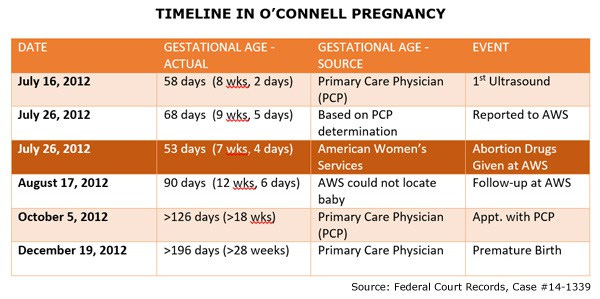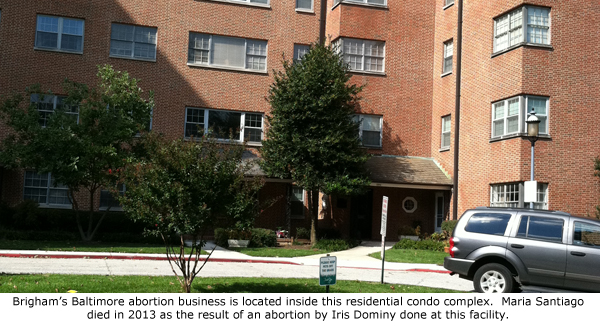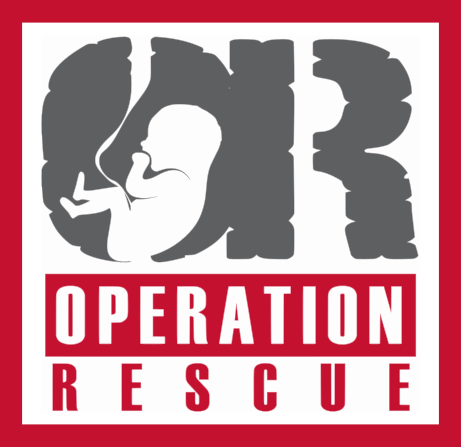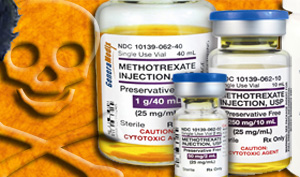Bottom-of-the-barrel abortionists use this cheap, ineffective abortion drug to financially exploit poor women at the cost of their safety

By Cheryl Sullenger
Frederick, Maryland — When Christy O’Connell reported to one of Steven Chase Brigham’s Maryland abortion facilities on July 26, 2012, she had no idea how that visit would alter her life.
According to court documents obtained by Operation Rescue, O’Connell’s experiences with Brigham’s notoriously shoddy abortion businesses resulted in the filing of three Federal Court lawsuits against Brigham and his medical director, Vikram Kaji, and two other abortionists then in his employment, Iris Dominy, and Mansour Panah.
It began in June 2012, when O’Connell first discovered that she was pregnant. A visit to her primary care provider on July 16, 2012, confirmed her pregnancy though a blood pregnancy test and a vaginal ultrasound, which determined that her baby was 8 weeks, 2 days (58 days) gestation.
Ten days later, on July 26, 2012, O’Connell reported to one of Brigham’s “American Women’s Services” abortion facilities in Frederick, Maryland.

It is doubtful that O’Connell was aware of Brigham’s abysmal reputation as a shoddy provider or that two years earlier, Brigham and his associate, Nicola Riley, had been caught conducting an illegal bi-state late-term abortion scheme in Maryland that nearly cost one patient her life, and resulted in the revocation of Riley’s Maryland medical license and Brigham’s last medical license in New Jersey.
Brigham himself never held a medical license in Maryland. Most of the time, when he wasn’t conducting illegal abortions without a license at his secret Elkton facility, Brigham depended on abortionists he hired to run his abortion businesses in Maryland. Those four facilities were part of a chain of 15 cut-rate abortion centers he operated in least four states from his headquarters in Voorhees, New Jersey.
Incompetent and unqualified
O’Connell consulted with Brigham employee and abortionist Iris Dominy during her visit to the Fredrick location.
There, O’Connell received a second ultrasound conducted by the “office manager,” who determined that O’Connell was only 7 weeks, 4 days (53 days) along, a completely inaccurate determination made by an employee who was not properly trained or qualified to conduct ultrasound examinations, much less interpret them, according to her suit.
Dominy completely depended on the ultrasound results provided to her by the unqualified staffer and never bothered to interpret or approve them.
After a discussion with Dominy, O’Connell decided to try a non-surgical abortion option. O’Connell’s abortion would involve two drugs, methotrexate and misoprostol, neither of which are approved by the FDA for use in abortions.
Dangerous drug

Methotrexate is a dangerous chemotherapy drug that carries with it a long list of serious side effects. It was used by abortionists in an off-label application to induce early abortions before the FDA approval of the abortion pill mifepristone, or RU486, in 2001. Since the mifepristone/misoprostol regimen has a slightly lower failure rate, methotrexate soon fell out of favor with all but the most disreputable abortion businesses in America.
Even according to the ever-dubious protocols developed by the National Abortion Federation, the continued use of methotrexate to induce abortions carries grave concerns and is not recommended for abortions beyond 56 days gestation. The NAF notes that due to the high failure rate, the few NAF abortionist that will actually still use methotrexate will not use it after 50 days gestation.
Just how high is the failure rate? The NAF indicates that for women 49 days pregnant or earlier, only 67% will abort within one week after one dose of methotrexate and misoprostol. It would take a second dose of misoprostol, a stomach ulcer drug that causes unpredictable and sometimes violent uterine contractions, in order for 80-85% of women to abort within two weeks.
But it gets worse. The failure rate of methotrexate and misoprostol actually doubles when used after 49 days of pregnancy. The dangers are so severe that the NAF advises that patients must have “ready access” to a telephone, emergency medical care, and transportation. The facilities administering the abortion drugs must also be capable of conducting surgical abortions in the likely event that the medications should fail.
O’Connell was actually 68 days pregnant when Dominy administered methotrexate and misoprostol to end her abortion. A failed or incomplete abortion was nearly assured.
O’Connell didn’t know that. She signed a consent form that indicated the drugs had only an 8% failure rate. That same consent form erroneously informed O’Connell that the more effective drug, mifepristone, was not yet available in the US, when in fact it had been in regular use for eleven years. The consent form went on to explain methotrexate can cause severe birth defects, which was about the only true thing she was ever told.
Profit over safety
So why even use methotrexate if it is so dangerous and ineffective? O’Connell’s complaint against Brigham and Kaji bluntly answers that question.
It is asserted that American Women’s Services, acting through its agents, Drs. Brigham and Kaji, prescribed methotrexate and misoprostol as therapy for medical abortions instead of other FDA-approved regimens in order to cut costs and maximize profits. In fact, one pill of mifepristone costs approximately $95, whereas one dose of methotrexate costs between $5 and $25. [Emphasis added.]
O’Connell paid just $310 for her abortion, a price Operation Rescue has confirmed AWS patients still currently pay. This is far below the national average cost for medication abortions of $568.50 and below the average cost in Maryland of $404.33. Brigham can afford to set his prices so low because he pays next to nothing for substandard, ineffective drugs. This undercuts the competition while maintaining a hefty profit margin. This cut-rate, predatory pricing primarily targets the poor for financial exploitation.
In addition, a predatory profit motive led Brigham and his associates to further cut corners on patient safety. Methotrexate is sold for intramuscular injection. There is a reference in the court documents that indicates O’Connell may have “ingested” the methotrexate drug orally. A health inspection of all four of Brigham’s Maryland abortion facilities discovered that oral administration of injectable methotrexate was standard procedure even though medical literature indicates that oral consumption only further increases the failure rate of the drug.
“Not only was Brigham too cheap to use approved drugs, he was too cheap to even by hypodermic needles so that the inferior drugs he bought could be properly injected. Cutting corners to maximize profits at the expense of women’s health and lives is a signature of Brigham abortion businesses. There is just no way that Brigham’s abortion chain should be allowed to continue to exploit women in this dangerous and despicable way,” said Troy Newman, President of Operation Rescue.
Too dangerous to operate
The Maryland Department of Health and Mental Hygiene agreed with Newman, and in March 2013, it issued an order immediately suspending the licenses of all four of Brigham’s known Maryland facilities after they refused to submit an acceptable correction plan for egregious violations discovered during inspections.
Those violations included:
• Failure to ensure all staff were trained in basic life support.
• Failure to ensure sonographers were properly trained and certified.
• Failure to maintain working emergency equipment.
• Failure to maintain a sanitary environment.
• Unlicensed workers dispensing misoprostol to abortion patients without doctor supervision and before the patient had been seen by a licensed physician.
The facility licenses were permanently suspended on May 9, 2013, and Brigham’s four Maryland abortion facilities were forced to shut down.
However, Brigham later quietly reopened at least three of them as medication-only abortion facilities, which allows them to operate without licensing, without inspection, and without accountability.
This is extremely problematic since medication abortions done at these facilities are dangerous, do not comply with FDA protocols, and are prone to complications such as those experienced by O’Connell.
Still pregnant
After receiving the abortion drugs on July 26, O’Connell returned to Brigham’s Frederick abortion clinic on August 17, 2012, for a follow up appointment. At that visit, she indicated she was still experiencing symptoms of pregnancy.
She was given a trans-abdominal ultrasound, (once again by an unqualified clinic worker), and told that no intrauterine pregnancy could be detected. She was told there was “no need” for a blood or urine pregnancy test because the ultrasound exam was “conclusive evidence” that she was not pregnant. O’Connell was told to visit her primary care provider in three months, handed a prescription for birth control pills, and sent on her way.
O’Connell continued to live her life believing she was not pregnant. She stayed on all her prescription medications, which included anti-depressants, asthma medication, and other drugs.
On October 5, 2012, O’Connell visited her primary care physician for a routine “well-woman” check-up. That was when her doctor discovered that O’Connell was still pregnant – now more than 18 weeks along.
Her prescriptions were immediately altered for the sake of her baby and she was designated a “high-risk” obstetrical patient. She saw her obstetrician almost every week.
Child’s suffering

When O’Connell reached about 28 weeks into her pregnancy, she was admitted to the hospital suffering from preeclampsia, a potentially dangerous condition involving extremely high blood pressure that can only be cured by the delivery of the baby.
On December 19, 2012, O’Connell’s son was born and rushed into the Neonatal Intensive Care Unity where he remained for almost two months. He suffers several medical conditions, some of which are due to his prematurity and some to the dangerous abortion drugs given his mother. He continues to be treated for hearing loss, developmental delays, heart defects, and “other problems.”
Now O’Connell is seeking damages against Brigham, Dominy, Vikram Kaji, and Mansour Panah in a Health Claims Alternative Dispute Resolution. Arbitration has been waived and the three initial complaints filed last year were combined into one case by the Federal Court in February, 2016.
Business as usual
Today, Brigham continues to operate his chain of 15 abortion offices in at least four states, even though his medical licenses in six states have been revoked or surrendered under threat of revocation. He has repeatedly, completely, and publicly been disgraced as an incompetent provider that poses a grave danger to the public, whose profit motives have always trumped patient safety.
Like his Maryland facilities, Brigham was forced to halt surgical abortions at his Delaware abortion office or risk being shut down after it was discovered that he failed to obtain the accreditation required of abortion businesses in that state. That office continues to sell medication abortions, thereby evading regulatory oversight.
If he is too dangerous to practice medicine, why is he allowed to manage and control medical protocols and policies at his shoddy abortion centers? Why is he allowed to operate medication abortion facilities that fly below the regulatory radar when his medication abortion protocols have been proven to be just as dangerous as surgical abortions at his facilities?
Patient death

Less than two months after the birth of O’Connell’s son, while he still lay in the NICU struggling for life, Iris Dominy’s incompetent abortion practices were responsible for yet another tragedy. Maria Santiago, 38, underwent a surgical abortion by Dominy at Brigham’s Baltimore office on February 13, 2013.
Santiago was left unattended and unmonitored while still under anesthesia. No one noticed when Santiago stopped breathing and went into cardiac arrest. By the time anyone checked on her, Santiago was motionless and not breathing at all. She was transported to the hospital where she was pronounced dead.
In May 2013, the Maryland State Board of Physicians suspended Dominy’s medical license. It was later restored with a reprimand and placed on probation. She was ordered not to commit any procedures that required sedation. Less than three months later, Dominy’s probation was terminated, but the sedation restriction still remains in effect.
The Frederick abortion facility where O’Connell received her “abortion” has since closed. While an AWS receptionist still tells callers that the facility is “undergoing “renovation,” the closure appears permanent. However, the three other Maryland American Women’s Services abortion facilities dangerously continue to offer methotrexate as an abortion option.
As for Kaji and Panah, who are also defendants on O’Connell’s suit, they have each had their own troubles.
Panah’s sex abuse and other problems
Mansour Panah has a disciplinary history going back to 1988 when his license was temporarily suspended after the Board determined that he had sexually assaulted three patients. In 1995, again fined for sexually abusing patients. Panah’s license was once again suspended in 2011 on charges related to a botched cosmetic surgical procedure and illegally transporting medical waste in his private vehicle.
In May, 2013, Panah’s license was suspended once again due to violations and the abortion-related death of Maria Santiago at Brigham facilities in Maryland where he served as the medical director. His license was reinstated only to be suspended again when he failed to show up for a disciplinary hearing.
Thankfully, on October 31, 2014, Panah sent a letter to the Maryland Board of Physicians permanently surrendering his medical license to avoid further disciplinary action and due to health issues, but this does not absolve him of responsibility for his part in the harm that was inflicted upon O’Connell and her son.
Kaji’s sex charges and incompetence
 Vikram Kaji, the medical director for Brigham’s abortion chain, also has a history of improper sexual conduct with his patients and had been disciplined in 2013 for failing to properly supervise Brigham’s New Jersey clinics.
Vikram Kaji, the medical director for Brigham’s abortion chain, also has a history of improper sexual conduct with his patients and had been disciplined in 2013 for failing to properly supervise Brigham’s New Jersey clinics.
Once Brigham lost his New Jersey license in 2015, he supposedly transferred ownership to Kaji. But Kaji denied he owned the clinics and insisted Brigham was still in charge. That prompted the New Jersey Attorney General’s office to file a complaint against Kaji in 2015 for going along with Brigham’s “sham” transfer. Finally, Brigham’s attorney was able to convince the Attorney General’s office that Brigham only administers the business end of the New Jersey American Women’s Services abortion facilities through his management company and has no medical duties or responsibilities.
“I don’t believe Brigham and don’t trust him to ever tell the truth. From our long dealings and research on him and his unscrupulous business practices, we know Brigham to be a man that will say whatever he thinks people want to hear. He is by definition a silver-tongued devil who cannot be taken at his word,” said Newman. “I have no doubt that Brigham is just as involved with his abortion business as he ever was.”
Despite Kaji’s documented incompetence, he continues as Medical Director for Brigham’s New Jersey abortion facilities, enabling Brigham’s bad behavior — all at great risk to women.
Lessons
As O’Connell’s lawsuit continues to wind its way through the system, several lessons should be learned from it.
• The use of methotrexate to induce abortions should be banned. It poses far too many risks to women and their babies in the all-too-likely event that the abortion drugs fail.*
• Maryland and other states should implement new laws to establish licensing and oversight for abortion facilities that provide medication-only abortions. These often-dangerous facilities are falling through the regulatory gaps and women are paying the price by suffering complications from corners-cutting and greed of unaccountable abortionists.**
• Given the decades of deception, disciplinary actions, and patient harm caused by Brigham’s American Women’s Services abortion chain, immediate steps should be taken by authorities in Maryland, New Jersey, Delaware, and Virginia, to shut down this chain of predatory, substandard abortion mills in the interest of public safety.
In addition, Operation Rescue has reason to believe that Steven Chase Brigham may still be illegally engaged in conducting abortions and is offering a $25,000 reward for information leading to his arrest and conviction. [Learn more here.]
“The only thing that will protect women and their babies from further exploitation and injury is to put Brigham behind bars where he belongs and shut down all of his abortion operations,” said Newman. “That seems to be just common sense. But don’t look for it to happen any time soon. Brigham has spent the better part of four decades learning new ways to violate the law and evade enforcement. In the meantime, women beware!”
Read O’Connell v. Brigham & Kaji
Read O’Connell v. American Women’s Services & Dominy
Read O’Connell v. Panah
____
*This is not to say that any other method of abortion is “safe” or acceptable. They are not. All abortions are immoral because they take an innocent human life, and all carry inherent and unacceptable risks to the lives and health of women.
**Operation Rescue works to end the barbaric practice of abortion in America. While regulation may not ban abortion, passing laws that establish regulatory oversight on all abortion businesses and limit certain abortion methods can lead to the closure of facilities that cannot or will not obey the law. This is proven to save lives by lowering abortion numbers and sparing women from at least some of the dangerous abortion businesses that are currently inflicting harm.






